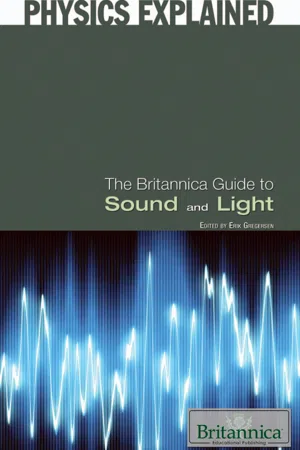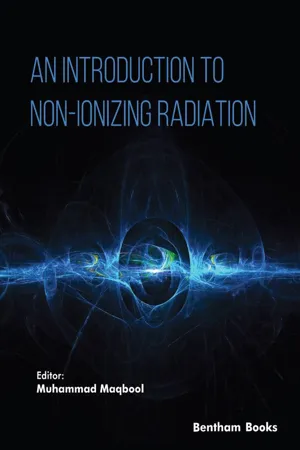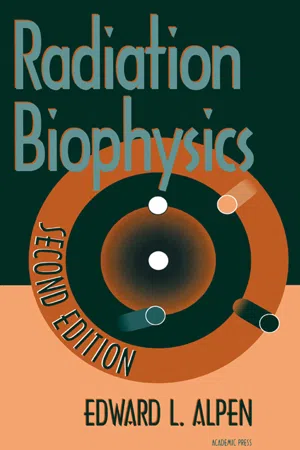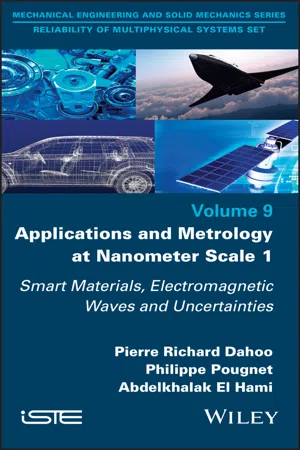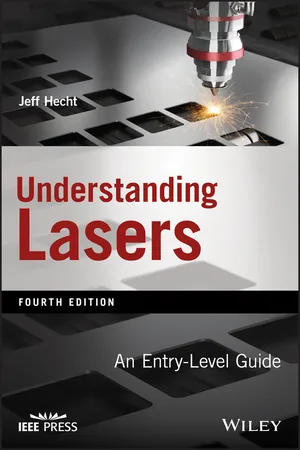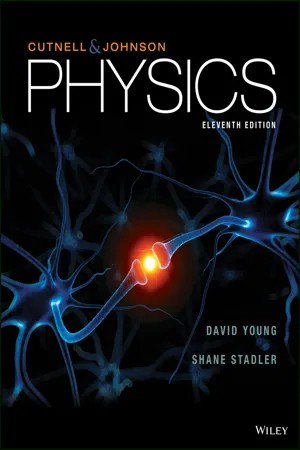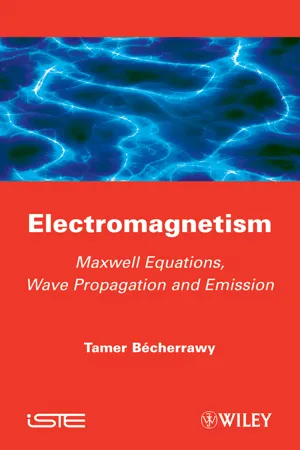Physics
Electromagnetic Energy
Electromagnetic energy refers to the energy carried by electromagnetic waves, which include visible light, radio waves, microwaves, and X-rays. These waves are created by the movement of electrically charged particles and can travel through a vacuum. Electromagnetic energy plays a fundamental role in various natural phenomena and technological applications.
Written by Perlego with AI-assistance
Related key terms
Related key terms
1 of 4
Related key terms
1 of 3
9 Key excerpts on "Electromagnetic Energy"
- eBook - ePub
- Britannica Educational Publishing, Erik Gregersen(Authors)
- 2010(Publication Date)
- Britannica Educational Publishing(Publisher)
CHAPTER 5 ELECTROMAGNETIC RADIATIONI n terms of classical theory, electromagnetic radiation is the flow of energy at the universal speed of light through free space or through a material medium in the form of the electric and magnetic fields that make up electromagnetic waves such as radio waves, visible light, and gamma rays. In such a wave, time-varying electric and magnetic fields are mutually linked with each other at right angles and perpendicular to the direction of motion. An electromagnetic wave is characterized by its intensity and the frequency ν of the time variation of the electric and magnetic fields.GENERAL CONSIDERATIONS
In terms of the modern quantum theory, electromagnetic radiation is the flow of photons (also called light quanta) through space. Photons are packets of energy h ν that always move with the universal speed of light. The symbol h is Planck’s constant, while the value of ν is the same as that of the frequency of the electromagnetic wave of classical theory. Photons having the same energy h ν are all alike, and their number density corresponds to the intensity of the radiation. Electromagnetic radiation exhibits a multitude of phenomena as it interacts with charged particles in atoms, molecules, and larger objects of matter. These phenomena as well as the ways in which electromagnetic radiation is created and observed, the manner in which such radiation occurs in nature, and its technological uses depend on its frequency ν. The spectrum of frequencies of electromagnetic radiation extends from very low values over the range of radio waves, television waves, and microwaves to visible light and beyond to the substantially higher values of ultraviolet light, X-rays, and gamma rays.OCCURRENCE AND IMPORTANCEClose to 0.01 percent of the mass/energy of the entire universe occurs in the form of electromagnetic radiation. All human life is immersed in it and modern communications technology and medical services are particularly dependent on one or another of its forms. In fact, all living things on Earth depend on the electromagnetic radiation received from the Sun and on the transformation of solar energy by photosynthesis into plant life or by biosynthesis into zooplankton, the basic step in the food chain in oceans. The eyes of many animals, including those of humans, are adapted to be sensitive to and hence to see the most abundant part of the Sun’s electromagnetic radiation—namely, light, which comprises the visible portion of its wide range of frequencies. Green plants also have high sensitivity to the maximum intensity of solar electromagnetic radiation, which is absorbed by a substance called chlorophyll that is essential for plant growth via photosynthesis. - eBook - ePub
- Muhammad Maqbool(Author)
- 2000(Publication Date)
- Bentham Science Publishers(Publisher)
Corresponding author Md. Kamal Hossain: Department of Electrical and Computer Engineering, The University of Alabama at Birmingham, Birmingham, AL 35294, USA; E-mail: khossain,[email protected]INTRODUCTION
An electromagnetic field is a property of space that combines the invisible forces of electric & magnetic fields. Four elemental forces exist in physics, known as the fundamental interactions, i.e., the gravitational force, the electromagnetic force, and the strong & weak forces. Typically, these forces govern how the particle interacts with each other based on the strength of the power, ranges of energy, and the particles' nature [1 ]. In the 19th century, Scottish physicist James Clerk Maxwell's discovered the concept of electromagnetic force (EMF) theory. It relates to the repulsion/attraction, the chemical behavior of the matter, and the lig-ht properties [2 ]. In the 1960s, Steven Weinberg and Sheldon Lee Glashow proposed the quantum field theory of electromagnetism that treats EMF everywhere in our environment. Environmental exposure increases significantly either human-made sources by household devices or workplace equipment that radiates Electromagnetic Energy (EME) from low to extremely high-frequencies [3 ].The emission of EME is the source of electromagnetic radiation (EMR). Typically, the EME describes all the energies released from the source of energy and travel through the propagation media with a constant speed of light, 3×108 m/sec. It comprises two independent components known as electric energy and magnetic energy [4 ]. Literature shows that around 0.01% of the total universe's energy occurs as the EMR [5 ]. For instance, human life immersed by EMR that emits from household equipment, personal electronic devices, radio, and television operates with EMR, modern communication technology depends on EMF, medical science uses EMR to observe the internal organ, etc [6 - 8 - eBook - ePub
- Edward L. Alpen(Author)
- 1997(Publication Date)
- Academic Press(Publisher)
E , can then be described as(2.3b)QUANTUM THEORY OF ELECTROMAGNETIC RADIATION
As suggested, Maxwell’s classical theory of electromagnetism proposed that energy is emitted in the form of electromagnetic waves when an electric charge is accelerated. Also a charge undergoing simple harmonic motion will generate electromagnetic waves with the same frequency as the moving charge. Planck’s formulation, a radical and anti-intuitive proposal for its time, suggests that the energy emitted by an oscillator is determined by its frequency, v , a constant, h , and an integer number, n . It says that the oscillator can have only a number of quantized energy steps determined by the value of n . The oscillators do not radiate energy in a continuum, but only in quantized steps determined by the quantum number n . Much later developments revealed a minor discrepancy in Planck’s formula, which is now written as(2.4)Planck’s constant, h , is equal to 6.63 × 10−34 J s (4.14 × 10−15 eV s).The concept of the quantized nature of an oscillator offended many of Planck’s colleagues of the time. They could indeed observe that the energy of, for example, an oscillating spring system or an electrical resistance-capacitance-inductance circuit seemed to have any value in a continuum, thus violating the “generality principle” of physical law. Readers can prove for themselves that there is indeed no conflict with the observed behavior of oscillators in macrosystems. The quantum numbers of such oscillators will be enormous, and the “jumps” in energy will not be apparent (see Problem 1 at the end of this chapter). Planck presented his concepts to the Berlin Physical Society on December 14, 1900. At that time his concept of the radiation emitted was that of an electromagnetic wave. It remained for Einstein to define the concept of the photon, a packet of energy that has both the wave properties of electromagnetic radiation, which are necessary for the understanding of diffraction and refraction, and the properties of a “bundle of energy,” the energy of which is defined by Planck’s law. - eBook - ePub
- Clive Maxfield, John Bird, Tim Williams, Walt Kester, Dan Bensky(Authors)
- 2011(Publication Date)
- Newnes(Publisher)
Chapter 20 Principles of Electromagnetics Ron SchmittHow does electromagnetic theory tie together such broad phenomena as electronics, radio waves, and light? Explaining this question in the context of electronics design is the main goal of this chapter. The basic philosophy is that by developing an understanding of the fundamental physics, you can develop an intuitive feel for how electromagnetic phenomena occur. Learning the physical foundations serves to build the confidence and skills to tackle real-world problems, whether you are an engineer, technician, or physicist. So, in the beginning of this chapter, we will review fundamentals of electrical engineering in the context of electromagnetics.The many facets of electromagnetics are due to how waves behave at different frequencies and how materials react in different ways to waves of different frequency. Quantum physics states that electromagnetic waves are composed of packets of energy called photons . At higher frequencies each photon has more energy. Photons of infrared, visible light, and higher frequencies have enough energy to affect the vibrational and rotational states of molecules and the electrons in orbit of atoms in the material. Photons of radio waves do not have enough energy to affect the bound electrons in a material. Furthermore, at low frequencies, when the wavelengths of the EM waves are very long compared to the dimensions of the circuits we are using, we can make many approximations leaving out many details. These low-frequency approximations give us the familiar world of basic circuit theory.20.1 The Need for Electromagnetics
So why would an electrical engineer need to know all this theory? There are many reasons why any and all electrical engineers need to understand electromagnetics. Electromagnetics is necessary for achieving electromagnetic compatibility of products, for understanding high-speed digital electronics, RF, and wireless, and for optical computer networking. - eBook - ePub
Applications and Metrology at Nanometer Scale 1
Smart Materials, Electromagnetic Waves and Uncertainties
- Pierre-Richard Dahoo, Philippe Pougnet, Abdelkhalak El Hami(Authors)
- 2021(Publication Date)
- Wiley-ISTE(Publisher)
hν), where ν is the frequency associated with the color of light. In the case of the photoelectric effect, induced absorption takes place. Modeling a black body as a source that radiates energy in discrete form, Planck solved the problem of the ultraviolet catastrophe of the black body emission. In 1915, Einstein explained the black body emission by introducing a symmetrical emission process in parallel with the absorption process that occurs in discrete form. Light can thus be considered as a wave or as a particle [BRO 68]. These approaches have been developed in specialized papers or books. The differences between classical sources (incoherent light) and quantum sources (coherent light) can be established from statistical theories of light. Notions of quantum mechanics are required to understand the particle nature of light in the form of photons [MES 64] [COH 73] such as the Glauber formulation, for example. To describe the state of wave polarization in a simplified form, a gauge is used to obtain the equation of the propagation of the electromagnetic wave in the transverse representation. This gauge choice makes it possible to express the electromagnetic field as a sum of independent oscillators (using creation and annihilation operators). This naturally leads to a quantum description of light in terms of photons, grains of light proposed by Einstein to interpret the photoelectric effect. It can be shown that energy is associated with a frequency and that light has a discrete character. Finally, Glauber’s approach connects the classical (continuous) and the quantum (discrete) descriptions and attributes a physical reality to coherent states with photons distributed according to a Poisson law.Nowadays, the wave–particle duality of light can be verified experimentally. The non-locality phenomenon was evidenced in the experiments conducted by Alain Aspect on quantum entanglement [ASP 82].This chapter is dedicated to various applications of electromagnetic waves. After having recalled the characteristics of these waves, applications are presented: the energy carried by a monochromatic plane wave, a rectangular waveguide, microwave antennas, the study of a wire antenna and antenna networks. These applications help understand the principles on which the fifth generation (5G) of mobile telecommunication systems are based.3.2. Characteristics of the energy carried by an electromagnetic wave
Electromagnetic waves carry energy. If is the electric field and is the magnetic field of the electromagnetic wave, the direction of the wave is the direction of the vector × .The Poynting vector is defined by:is expressed in joule per second per unit surface [(J/(s.m2 )].The norm of the Poynting vector represents the instantaneous power carried by the electromagnetic wave through the unit surface. The Poynting vector is perpendicular to the wave direction of propagation.The Poynting vector can also be written in the following integral form (though denoted by the same letter, the energy E and the electric field should not be confused):where is the unit vector perpendicular to dS .For a plane electromagnetic wave, the norm of the Poynting vector is:This quantity varies in time and space. In a given position, its average value is sin2 ( ) averaged over period T - eBook - ePub
Understanding Lasers
An Entry-Level Guide
- Jeff Hecht(Author)
- 2018(Publication Date)
- Wiley-IEEE Press(Publisher)
CHAPTER 2 PHYSICAL BASICS ABOUT THIS CHAPTER Lasers evolved from concepts of modern physics that emerged early in the 20th century. To understand lasers, you need to understand basic concepts including light, atomic energy levels, quantum mechanics, and optics. This chapter starts with the nature of light, then moves on to how light is generated, the interactions of light and matter, and some fundamentals of optics and fiber optics, to give you the background you need to understand lasers themselves. 2.1 ELECTROMAGNETIC WAVES AND PHOTONS Early physicists debated long and loud over the nature of light. In the 17th century, Christian Huygens believed light was made up of waves, but Isaac Newton held that light was made up of tiny particles. Newton's theory was thought to be right for a century, until Thomas Young showed the interference of light, which could only be explained by waves. Today, we know that both theories are partially right. Much of the time, light behaves like a wave. Light is called an electromagnetic wave because it consists of electric and magnetic fields perpendicular to each other, as shown in Figure 2.1. Because the electric and magnetic fields oscillate perpendicular to the direction in which the waves travel, they are called transverse waves. Figure 2.1 Structure of an electromagnetic wave. At other times, light behaves like massless particles called photons. A photon is a quantum of Electromagnetic Energy, not the hard particle that Newton envisioned. The quantum view that light comes in discrete chunks rather than a continuous wave is also critical to understanding light. We will move back and forth between the wave and particle views of light, but you should remember that they are just different ways to look at the same thing. We also include some simple formulas, explaining them in words to help you understand what they mean - Tamer Bécherrawy(Author)
- 2013(Publication Date)
- Wiley-ISTE(Publisher)
6.10. Electromagnetic spectrumAn electromagnetic wave carries energy; thus, it cannot be emitted by charges at rest or in uniform motion: only accelerated charges (or variable currents) may emit them. If the current is a simple harmonic function of time, the emitted wave is a simple harmonic of equal frequency. The emitter of a wavelength λ is always a system whose dimensions are comparable to λ. For instance, waves with wavelengths of roughly more than 1 mm are emitted by macroscopic systems (electronic or electric).While propagating, the electromagnetic waves experiences the various effects due to the propagation medium and eventual obstacles. The most important effects are the decrease of intensity with the increasing distance like 1/r 2 (in the case of isotropic emission), reflection on surfaces with large dimensions compared to the wavelength, diffraction by apertures and obstacles with dimensions comparable to λ , and absorption by the medium, etc.The most important applications of electromagnetic waves are in the domain of telecommunications. Information (sound, image, etc.) may be transmitted by modulated waves , that is, of amplitude, frequency or phase that vary according to the information. The modulation is realized using an input transducer , which transforms the information into an electric signal. Microphones and photoelectric cells are examples of input transducers. In the receiver, an output transducer transforms the electrical signal of the modulated wave into a non-electrical signal. A loudspeaker and a liquid crystal screen are examples of output transducers. The extracted signal reproduces the original signal with more or less deformations depending on the quality of the system.Here is a classification of electromagnetic waves according to their frequency (or their wavelength ) and some of their principal uses.1) Waves with industrial frequencies (30 Hz < < 3 kHz and 105 m < λ < 107 m): they are emitted by ac- eBook - ePub
- John D. Cutnell, Kenneth W. Johnson, David Young, Shane Stadler(Authors)
- 2018(Publication Date)
- Wiley(Publisher)
c provided a basis for inferring that light behaves as a wave consisting of oscillating electric and magnetic fields.Check Your Understanding
(The answer is given at the end of the book.)4. The frequency of electromagnetic wave A is twice that of electromagnetic wave B. For these two waves, what is the ratioλA /λBof the wavelengths in a vacuum?(a)λA /λB = 2, because wave A has twice the speed that wave B has.(a)λA /λB = 2, because wave A has one-half the speed that wave B has.(a), because wave A has one-half the speed that wave B has.λ A/λ B=1 2(a), because wave A has twice the speed that wave B has.λ A/λ B=1 2(a), because both waves have the same speed.λ A/λ B=1 224.4 The Energy Carried by Electromagnetic Waves
THE PHYSICS OF … a microwave oven. Electromagnetic waves, like water waves or sound waves, carry energy. The energy is carried by the electric and magnetic fields that comprise the wave. In a microwave oven, for example, microwaves penetrate food and deliver their energy to it, as Figure 24.14 illustrates. The electric field of the microwaves is largely responsible for delivering the energy, and water molecules in the food absorb it. The absorption occurs because each water molecule has a permanent dipole moment; that is, one end of a molecule has a slight positive charge, and the other end has a negative charge of equal magnitude. As a result, the positive and negative ends of different molecules can form a bond. However, the electric field of the microwaves exerts forces on the positive and negative ends of a molecule, causing it to spin. Because the field is oscillating rapidly—about2.4 × 109 - eBook - ePub
Electromagnetism
Maxwell Equations, Wave Propagation and Emission
- Tamer Becherrawy(Author)
- 2013(Publication Date)
- Wiley-ISTE(Publisher)
L ). Thus, the equivalent inductance of the plasma per unit volume is[10.138]The plasma behaves as an inductance that dissipates no energy. If we do not neglect the collisions of electrons with themselves and with the positive ions at rest, a certain amount of energy is dissipated and this corresponds to a supplementary resistance of the plasma.10.9. Quantization of electromagnetic waves
According to classical concepts, a wave is extended in space and time with a certain continuous distribution of physical quantities, such as energy and momentum and a continuous flux of these quantities. However, some effects of emission and absorption of electromagnetic waves, such as the photoelectric effect , discovered by Hertz in 1887 and interpreted by Einstein in 1905, can be understood only if the wave is really constituted of “packets” of energy; we say that the wave is quantized . The quantum of radiation, called photon , of frequency has an energy[10.139 ]h is Planck's constant . The effects of radiation are fundamentally due to the interaction of a single photon with matter. Thus, they depend on its energy, i.e. its frequency or wavelength . A shorter wavelength corresponds to a more energetic photon and, consequently, a more important effect of the radiation.If N v is the number of photons per unit volume of the wave, its energy density is U EM,v = N v h . According to the relation [10.75] , the wave also has a momentum density P EM,v = U EM,v /c = N v h /c . Thus, the momentum of each photon is[10.140 ]where λ is the wavelength. De Broglie generalized this relation to all particles.According to the special theory of relativity, the energy and the momentum of a particle of mass m are related by the equation . Thus, the relation E γ = cp γ implies that the photon has no mass. The expressions [10.139] and [10.140] for the energy and momentum of the photon are confirmed by all experiments, notably the Compton effect
Index pages curate the most relevant extracts from our library of academic textbooks. They’ve been created using an in-house natural language model (NLM), each adding context and meaning to key research topics.
Explore more topic indexes
Explore more topic indexes
1 of 6
Explore more topic indexes
1 of 4
